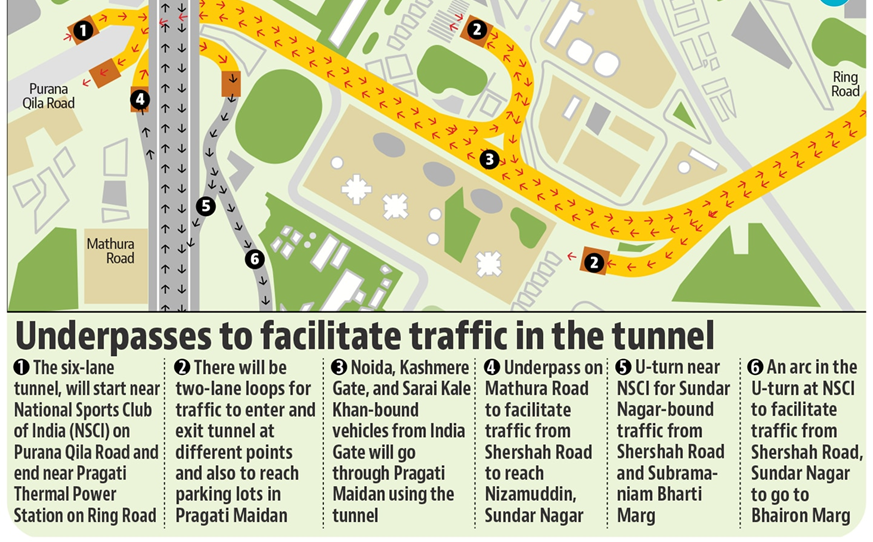In News:
- Recently, the PM Modi inaugurated the main tunnel and five underpasses of the Pragati Maidan Integrated Transit Corridor project.
- One of the key aim of this project is to decongest traffic around the Pragati Maidan Trade Centre, New Delhi.
What’s in today’s article:
- The Pragati Maidan Integrated Transit Corridor project (About, purpose, significance)
The Pragati Maidan Integrated Transit Corridor project:

- About:
- An integral part of the ITPO-Pragati Maidan Redevelopment Project, the corridor comprises a 1.3-km long tunnel (national capital’s first road tunnel) and six underpasses.
- Work on the project began in 2017 and was expected to be completed by the end of 2019. However, it missed several deadlines.
- The project is funded entirely by the Central government and executed by the Delhi government's Public Works Department (PWD).
- Purpose of the project:
- Heavy traffic was seen on Purana Qila and the Delhi Zoo Road due to back-to-back traffic signals at the intersections of Sher Shah Road and ITO W - junction in New Delhi.
- Furthermore, a large number of vehicles travelling from Ghaziabad, Noida and East Delhi on the Yamuna river side choking Bhairon Marg, India Gate Circle, Mathura Road and Ring Road.
- Therefore, the prime objective of this project is to decongest traffic around the Pragati Maidan Trade Centre and remove bottlenecks on Bhairon Marg, Ring Road, ITO-W point and Mathura Road and make it signal free.
- Significance of the project:
- Seamless connectivity: It will provide seamless connectivity between -
- East and Central Delhi, East and New Delhi and Southeast and Central Delhi.
- It will also make commuting from Noida, Ghaziabad, Faridabad and Badarpur easier.
- Huge parking space: It also provides access to the huge basement parking lot at Pragati Maidan trade centre.
- A unique feature of the tunnel is two cross tunnels below the main tunnel that have been constructed to facilitate movement of traffic from either side of the parking lot.
- Cut Co2 emissions: An analysis by The Energy and Resources Institute (TERI) shows that the Project will reduce Co2 emissions by around 12,400 tonnes each year.
- TERI is a leading think tank dedicated to conducting research for sustainable development of India and the Global South.
- It was established in 1974 as an information centre on energy issues.
- TERI's key focus lies in promoting: Clean energy; Water management; Pollution management; Sustainable agriculture; Climate resilience
- Ensuring ease of living: By helping save time and cost of commuters in a big way.









